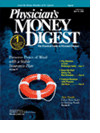Publication
Article
Physician's Money Digest
Pay Attention to Fund Brokerage Costs
Author(s):
Wall Street Journal
It's time for my periodic rant about the outrageouscosts of most mutual funds. The issue isgetting some attention in connection with theunfolding mutual fund scandals. The outrageouscosts, however, form the biggest scandal. A recentstory in the , based on a study byLipper Inc, shows that fund costs may be much higherthan we generally think. The problem may neverreceive the attention it deserves. So it's up to physician-investors to fend for themselves and recognizethe importance of fund costs.
Impacting Fund Costs
The two most commonly recognized fund costsare the front-end load and expense ratio. The front-endload is simply a sales charge taken out before yourmoney is invested. It can be as high as 6%. Theexpense ratio, which is always expressed as an annualnumber, includes a fund's management fees, overhead,and a few other costs. Funds are required to discloseit prominently. The expense ratios average1.68% for all stock mutual funds, can be as low as0.2% for index funds, and are even lower forexchange-traded funds.
Unfortunately, there are several other costs, whichare nearly impossible to find. Probably the largest ofthese is the brokerage fees that a fund pays to buy andsell the stocks and bonds it holds. Most investors andeven many financial professionals think that thesecosts are relatively small. But the Lipper study of 2000mutual funds shows that brokerage commissions canmore than double the costs of owning a fund's shares.
The best way to understand the long-term impactof all these costs is to look at a few examples. Assumethat you invest $100,000 in the average stock mutualfund with a total annual cost of 3.4% (ie, 1.7%expense ratio + 1.7% brokerage fees) and hold it for20 years. Also assume that the fund has no loads andearns an average annual return of 10% over the periodbefore the costs.
At the end of the period, your investment willgrow to about $360,000. Sure, this sounds good—until you recognize that if the brokerage fees were amore reasonable 0.3% per year instead of the 1.7%,you would have accumulated $466,000.
In addition, if you had invested in an index fundwith a total annual cost of 0.25%, your ending balancewould have been over $640,000. Note: All casesassume a 10% average annual return before costs.
Fundamental Justification
The justification you will hear most often for thesehigh costs is that the performance of a fund is alwaysreported after all costs. So, if a high-cost fund has historicallyperformed better than a low-cost or index fundafter all costs, why should you care about the costs? Youshouldn't begrudge the fund manager and the brokers; inthis scenario, everyone comes out ahead. The problem:A fund with high costs is running a marathon with a lotof extra weight on its back. It may do well for the firstfew miles, but chances are, it will fall far behind by theend of the race.
What can be even more deceptive is that you canalmost always find a few high-cost funds that havedone better than low-cost options over the long run.But more often than not, this happens by chance. Youhave no way of knowing which high-cost fund will dowell over the long run. You will most likely come outahead if you bet on the runner with as little weight onits back as possible.
Recognizing Your Clue
Most physician-investors can easily find the frontendload and expense ratio of a fund. But how do youfind the brokerage fees it pays? Under current disclosurerules, this is very difficult. Although some politiciansand regulators are trying to require fuller disclosure,the industry is resisting, arguing that that wouldbe expensive and confusing. The industry's argumentsmake little sense, but chances are, you won't see betterdisclosure anytime soon.
In the meantime, use the turnover ratio of a fundas a reasonable indicator of its brokerage costs. Afund with a turnover ratio of 20% or so is not likelyto have unreasonably high brokerage costs; one witha turnover ratio of 100% or higher is most likely runningwith too much weight on its back.
Chandan Sengupta, author of The Only ProvenRoad to Investment Success (John Wiley; 2001),currently teaches finance at the Fordham UniversityGraduate School of Business and consultswith individuals on financial planning and investmentmanagement. He welcomes questions orcomments at chandansen@aol.com.
